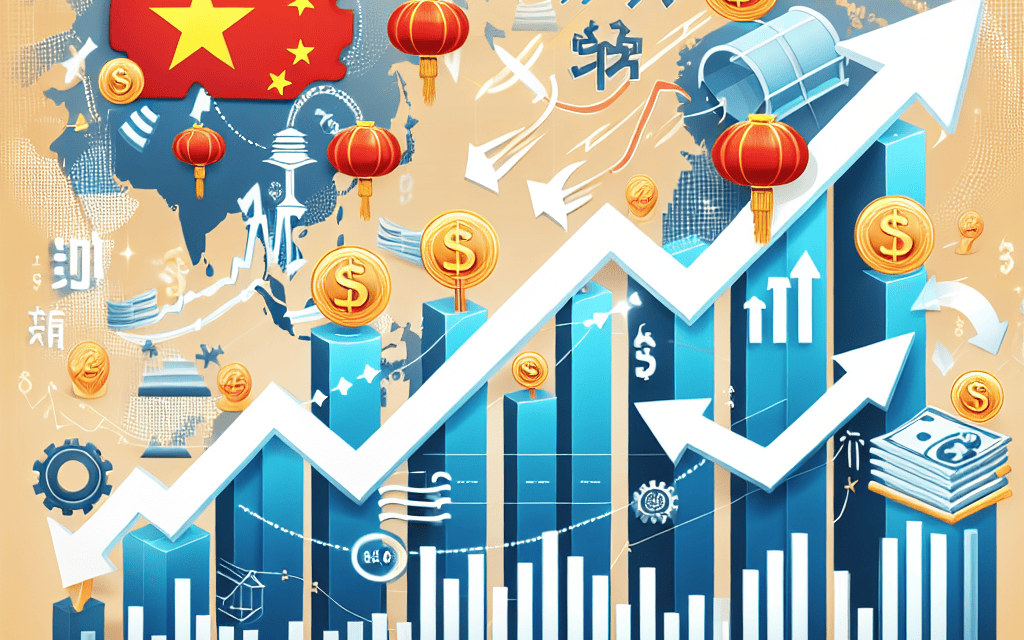“Asia Stocks Surge: China’s Buyback Boost and GDP Growth Ignite Market Optimism”
Introduction
Asian stock markets experienced an upswing as investor sentiment was buoyed by China’s recent corporate buyback initiatives and robust GDP growth figures. The Chinese government’s strategic move to encourage share buybacks has instilled confidence among investors, signaling a commitment to stabilizing and invigorating the market. This development, coupled with China’s impressive GDP growth, has had a ripple effect across the region, lifting stock indices and fostering optimism about economic recovery and expansion. As a result, markets in Japan, South Korea, and other Asian economies have also seen positive momentum, reflecting the broader impact of China’s economic policies and performance on the regional financial landscape.
Impact Of China’s Buyback Initiatives On Asian Stock Markets
The recent surge in Asian stock markets can be largely attributed to China’s strategic buyback initiatives and its robust GDP growth, which have collectively instilled a renewed sense of optimism among investors. As the world’s second-largest economy, China’s financial maneuvers often have a ripple effect across the region, influencing market dynamics and investor sentiment. The buyback initiatives, in particular, have played a pivotal role in bolstering market confidence, as they signal a commitment to stabilizing and enhancing the value of Chinese companies. This move has been perceived as a proactive measure to counteract market volatility and to reassure investors of the underlying strength of these enterprises.
In tandem with these buyback initiatives, China’s impressive GDP growth figures have further fueled the positive momentum in Asian stock markets. The country’s economic expansion, driven by a combination of domestic consumption, infrastructure investment, and export resilience, has exceeded expectations, providing a solid foundation for market optimism. This growth trajectory not only underscores China’s economic resilience but also highlights its pivotal role in the broader Asian economic landscape. As a result, investors are increasingly viewing China as a beacon of stability and growth potential, which in turn has spurred increased capital inflows into the region.
Moreover, the impact of China’s economic policies extends beyond its borders, influencing neighboring economies and their respective stock markets. Countries with strong trade ties to China, such as South Korea, Japan, and Taiwan, have experienced a positive spillover effect, as their export-driven sectors benefit from China’s robust demand. This interconnectedness underscores the importance of China’s economic health to the broader Asian market ecosystem. Consequently, the positive developments in China have led to a ripple effect, boosting investor confidence across the region and contributing to the upward trajectory of Asian stock indices.
Furthermore, the strategic timing of China’s buyback initiatives cannot be overlooked. In an era marked by global economic uncertainties, including fluctuating commodity prices and geopolitical tensions, China’s decisive actions have provided a much-needed anchor for investors seeking stability. By implementing these buybacks, Chinese companies are effectively signaling their confidence in their long-term growth prospects, which has been instrumental in mitigating concerns over potential market downturns. This assurance has been particularly crucial for foreign investors, who often view buybacks as a sign of corporate health and a commitment to shareholder value.
In addition to the direct impact on stock prices, China’s initiatives have also fostered a more favorable investment climate in the region. The increased liquidity resulting from buybacks has enhanced market efficiency, making it easier for investors to execute trades and manage their portfolios. This improved market environment has attracted a diverse range of investors, from institutional players to retail participants, further contributing to the vibrancy and dynamism of Asian stock markets.
In conclusion, the rise in Asian stocks can be attributed to a confluence of factors, with China’s buyback initiatives and GDP growth playing a central role. These developments have not only bolstered market confidence but have also underscored China’s significance as a key driver of regional economic stability. As investors continue to navigate the complexities of the global financial landscape, the positive signals emanating from China are likely to remain a crucial determinant of market sentiment and performance in Asia.
How China’s GDP Growth Fuels Asian Stock Market Surge
The recent surge in Asian stock markets can be largely attributed to China’s strategic buyback initiatives and its robust GDP growth. As the world’s second-largest economy, China’s economic health significantly influences the broader Asian market landscape. The country’s recent economic policies and performance have provided a much-needed boost to investor confidence, leading to a notable rise in stock prices across the region.
China’s government has been proactive in implementing measures to stabilize and invigorate its financial markets. One of the key strategies has been the encouragement of share buybacks by Chinese companies. This initiative aims to enhance shareholder value and signal corporate confidence in future growth prospects. By repurchasing shares, companies reduce the number of outstanding shares, thereby increasing earnings per share and often leading to a rise in stock prices. This move has been well-received by investors, who view it as a sign of corporate strength and a commitment to long-term growth.
In tandem with these buyback initiatives, China’s GDP growth has been a critical factor in the positive momentum observed in Asian stock markets. Despite global economic uncertainties, China has managed to maintain a steady growth trajectory, driven by strong domestic consumption, technological advancements, and strategic investments in infrastructure. The country’s GDP growth rate has consistently outpaced many other major economies, reinforcing its position as a key driver of regional economic activity.
Moreover, China’s economic resilience has had a ripple effect on neighboring countries, many of which are closely tied to China’s supply chain and trade networks. As China’s economy expands, demand for goods and services from these countries increases, boosting their own economic growth and, consequently, their stock markets. This interconnectedness underscores the importance of China’s economic performance in shaping the broader Asian financial landscape.
Furthermore, the positive sentiment surrounding China’s economic policies and growth prospects has attracted foreign investment into the region. International investors, seeking to capitalize on the growth potential of Asian markets, have increased their exposure to stocks in the region. This influx of capital has further fueled the upward trajectory of stock prices, creating a virtuous cycle of growth and investment.
In addition to these factors, China’s commitment to technological innovation and sustainable development has also played a role in bolstering investor confidence. The country’s focus on sectors such as renewable energy, electric vehicles, and digital technology aligns with global trends and positions it as a leader in the transition to a more sustainable and technologically advanced economy. This strategic direction not only supports China’s long-term growth but also enhances its appeal to investors looking for opportunities in emerging industries.
In conclusion, the rise in Asian stock markets can be attributed to a combination of China’s strategic buyback initiatives and its impressive GDP growth. These factors have not only strengthened investor confidence in Chinese companies but have also had a positive impact on the broader regional market. As China continues to implement policies that support economic stability and growth, it is likely that Asian stock markets will continue to benefit from the country’s economic dynamism. The interconnectedness of regional economies, coupled with China’s commitment to innovation and sustainability, suggests a promising outlook for investors in the Asian market.
Analyzing The Role Of Government Policies In Asia’s Stock Market Rally
Asia’s stock markets have recently experienced a notable rally, driven in part by China’s strategic buyback initiatives and robust GDP growth. This upward trend underscores the significant role that government policies play in shaping market dynamics across the region. As investors and analysts closely monitor these developments, it becomes increasingly clear that government interventions can have profound and far-reaching impacts on market performance.
To begin with, China’s buyback initiatives have been a pivotal factor in bolstering investor confidence. By encouraging state-owned enterprises and private companies to repurchase their own shares, the Chinese government aims to stabilize stock prices and enhance shareholder value. This move not only signals confidence in the underlying strength of these companies but also serves to reduce market volatility. As a result, investors are more inclined to view the market as a safe and attractive investment destination, leading to increased capital inflows and a subsequent rise in stock prices.
In addition to buyback initiatives, China’s impressive GDP growth figures have further fueled the stock market rally. The country’s economy has demonstrated resilience in the face of global uncertainties, with strong domestic consumption and industrial output driving growth. This economic expansion provides a solid foundation for corporate earnings, which in turn supports higher stock valuations. Consequently, investors are more optimistic about the future prospects of Chinese companies, contributing to the overall positive sentiment in the market.
Moreover, the impact of China’s policies extends beyond its borders, influencing stock markets across Asia. As the region’s largest economy, China’s economic health is closely intertwined with that of its neighbors. Therefore, when China implements policies that boost its own market, the ripple effects are felt throughout Asia. For instance, countries with strong trade ties to China, such as South Korea and Japan, often experience increased demand for their exports, which can lead to improved corporate earnings and higher stock prices. This interconnectedness highlights the importance of China’s policy decisions in shaping the broader regional market landscape.
Furthermore, it is essential to consider the role of other Asian governments in supporting their respective stock markets. Many countries in the region have implemented their own measures to stimulate economic growth and enhance market stability. For example, monetary policies such as interest rate cuts and quantitative easing have been employed to encourage borrowing and investment. Additionally, fiscal policies, including infrastructure spending and tax incentives, have been utilized to spur economic activity. These government actions, in conjunction with China’s initiatives, create a favorable environment for stock market growth across Asia.
In conclusion, the recent rally in Asia’s stock markets can be largely attributed to the strategic policies implemented by governments, particularly China’s buyback initiatives and strong GDP growth. These measures have not only bolstered investor confidence but also provided a solid foundation for sustained market performance. As the interconnectedness of global economies continues to deepen, the influence of government policies on stock markets is likely to remain a critical factor in shaping future trends. Investors and analysts alike must remain vigilant in monitoring these developments, as they hold the potential to significantly impact market dynamics across the region.
Investor Sentiment In Asia Amid China’s Economic Strategies

Investor sentiment in Asia has experienced a notable uplift, driven by China’s recent economic strategies, particularly its buyback initiatives and robust GDP growth. These developments have not only bolstered confidence within the region but have also had a ripple effect on global markets. As investors closely monitor China’s economic maneuvers, the positive momentum in Asian stocks underscores the significance of these strategies in shaping market dynamics.
China’s buyback initiatives have emerged as a pivotal factor in enhancing investor confidence. By encouraging state-owned enterprises and private companies to repurchase their shares, the Chinese government aims to stabilize the stock market and boost investor morale. This move is perceived as a commitment to supporting the domestic market, thereby reducing volatility and fostering a more favorable investment climate. Consequently, investors are increasingly optimistic about the potential for sustained growth, as these buybacks are expected to enhance earnings per share and improve overall market sentiment.
In tandem with the buyback initiatives, China’s impressive GDP growth figures have further fueled investor enthusiasm. The country’s economy has demonstrated resilience, with growth rates surpassing expectations despite global economic uncertainties. This robust performance is attributed to a combination of factors, including strong domestic consumption, increased infrastructure spending, and a rebound in exports. As a result, investors are gaining confidence in China’s ability to navigate economic challenges and maintain its growth trajectory, which in turn has a positive impact on Asian stock markets.
Moreover, the interplay between China’s economic strategies and regional market dynamics cannot be overlooked. As the largest economy in Asia, China’s policies have a profound influence on neighboring countries. The positive sentiment generated by China’s buyback initiatives and GDP growth has spilled over into other Asian markets, leading to a broader rally in regional stocks. Investors are increasingly viewing Asia as an attractive investment destination, driven by the belief that China’s economic stability will have a stabilizing effect on the entire region.
Furthermore, the global context in which these developments are unfolding adds another layer of complexity to investor sentiment. With ongoing geopolitical tensions and economic uncertainties in other parts of the world, Asia’s relative stability and growth prospects are becoming more appealing to international investors. China’s proactive measures to support its economy are seen as a counterbalance to global volatility, making Asian markets an attractive option for those seeking diversification and growth opportunities.
In addition to these factors, the role of technology and innovation in driving economic growth in Asia cannot be understated. As China continues to invest in cutting-edge technologies and digital infrastructure, the potential for long-term growth remains promising. This focus on innovation not only enhances productivity but also positions Asia as a leader in the global tech landscape. Consequently, investors are increasingly drawn to the region’s burgeoning tech sector, further boosting market sentiment.
In conclusion, the rise in Asian stocks, fueled by China’s buyback initiatives and impressive GDP growth, reflects a broader trend of increasing investor confidence in the region. As China continues to implement strategic economic measures, the positive impact on regional markets is likely to persist. With Asia’s growing prominence on the global stage, investors are keenly observing the unfolding economic landscape, recognizing the potential for sustained growth and stability in the region.
Sector-Wise Breakdown Of Stock Gains In Asia
Asia’s stock markets have recently experienced a notable upswing, driven by China’s strategic buyback initiatives and robust GDP growth. This positive momentum has been reflected across various sectors, each contributing uniquely to the overall market gains. As investors navigate this dynamic landscape, understanding the sector-wise breakdown of stock gains provides valuable insights into the underlying economic forces at play.
The technology sector has been a significant beneficiary of the recent market rally. China’s commitment to bolstering its tech industry through buyback initiatives has instilled confidence among investors. Companies in this sector have seen their stock prices rise as they capitalize on increased government support and favorable market conditions. The emphasis on innovation and digital transformation has further fueled growth, with tech firms expanding their product offerings and exploring new markets. Consequently, the technology sector has emerged as a key driver of stock gains in Asia, reflecting the region’s growing influence in the global tech arena.
In parallel, the financial sector has also experienced substantial growth, buoyed by China’s impressive GDP figures. The country’s economic expansion has led to increased consumer spending and investment activities, benefiting banks and financial institutions. As a result, financial stocks have seen a surge in demand, with investors optimistic about the sector’s long-term prospects. Additionally, regulatory reforms aimed at enhancing transparency and stability have further strengthened investor confidence, contributing to the sector’s robust performance.
Meanwhile, the consumer goods sector has witnessed a steady rise in stock prices, driven by a combination of factors. China’s burgeoning middle class and rising disposable incomes have spurred demand for consumer products, ranging from everyday essentials to luxury items. Companies in this sector have capitalized on these trends by expanding their product lines and enhancing their distribution networks. Moreover, the shift towards e-commerce and digital retailing has opened new avenues for growth, enabling consumer goods firms to reach a broader audience and boost sales. This sector’s resilience and adaptability have made it a significant contributor to the overall stock market gains in Asia.
The industrial sector, too, has played a crucial role in the recent market rally. China’s infrastructure development initiatives and increased manufacturing activities have driven demand for industrial goods and services. Companies involved in construction, machinery, and logistics have experienced heightened investor interest, as they stand to benefit from the ongoing economic expansion. Furthermore, the push towards sustainable and green technologies has created new opportunities for industrial firms, aligning with global trends and enhancing their growth prospects.
Lastly, the healthcare sector has emerged as a notable performer, reflecting the growing importance of health and wellness in the region. The COVID-19 pandemic has underscored the need for robust healthcare systems, prompting increased investment in medical research, pharmaceuticals, and healthcare services. Companies in this sector have responded by innovating and expanding their offerings, catering to the rising demand for quality healthcare solutions. As a result, healthcare stocks have gained traction among investors, contributing to the overall positive sentiment in Asia’s stock markets.
In conclusion, the recent rise in Asia’s stock markets can be attributed to a confluence of factors, including China’s buyback initiatives and strong GDP growth. The sector-wise breakdown of stock gains highlights the diverse drivers of this upward trend, with technology, financials, consumer goods, industrials, and healthcare all playing pivotal roles. As these sectors continue to evolve and adapt to changing market dynamics, they are likely to remain integral to Asia’s economic growth story, offering promising opportunities for investors in the region.
Long-Term Implications Of China’s Economic Growth On Asian Markets
The recent surge in Asian stock markets, driven by China’s strategic buyback initiatives and robust GDP growth, has sparked considerable interest among investors and analysts alike. This development not only highlights the immediate impact of China’s economic policies but also prompts a deeper examination of the long-term implications for Asian markets. As China continues to assert its economic prowess, the ripple effects are expected to shape the financial landscape across the region in profound ways.
To begin with, China’s buyback initiatives have played a pivotal role in bolstering investor confidence. By encouraging state-owned enterprises and private companies to repurchase their shares, the Chinese government aims to stabilize stock prices and enhance market liquidity. This move is particularly significant in the context of global economic uncertainties, as it signals a commitment to maintaining economic stability. Consequently, other Asian markets are likely to benefit from this increased confidence, as investors seek opportunities in a more stable and predictable environment.
Moreover, China’s impressive GDP growth further underscores its position as a key driver of regional economic expansion. With a growth rate that consistently outpaces many other major economies, China serves as a vital engine for the broader Asian market. This growth is not only a testament to China’s domestic economic policies but also reflects its expanding influence in global trade. As China continues to invest in infrastructure and technology, neighboring countries are poised to benefit from increased trade and investment opportunities. This interconnectedness fosters a more integrated regional economy, which can lead to sustained growth across Asia.
In addition to these immediate effects, the long-term implications of China’s economic growth on Asian markets are multifaceted. One significant aspect is the potential for increased economic integration within the region. As China strengthens its economic ties with neighboring countries through initiatives such as the Belt and Road Initiative, there is a growing impetus for regional cooperation. This collaboration can lead to the development of new trade routes, improved infrastructure, and enhanced economic partnerships, all of which contribute to a more resilient and interconnected Asian market.
Furthermore, China’s economic growth presents both opportunities and challenges for other Asian economies. On one hand, countries with strong trade links to China stand to benefit from increased demand for their exports. On the other hand, there is a risk of over-reliance on the Chinese market, which could expose these economies to vulnerabilities in the event of a slowdown. Therefore, it is crucial for Asian countries to diversify their economic partnerships and develop strategies to mitigate potential risks associated with China’s economic dominance.
In conclusion, the rise in Asian stocks, fueled by China’s buyback initiatives and GDP growth, is indicative of the broader economic trends shaping the region. While the immediate effects are evident in increased investor confidence and market stability, the long-term implications are more complex and far-reaching. As China continues to play a central role in the regional economy, Asian markets must navigate the opportunities and challenges that arise from this dynamic landscape. By fostering economic integration and diversification, the region can harness the potential of China’s growth while ensuring sustainable development for the future.
Comparing Asian Stock Performance With Global Markets Amid China’s Initiatives
In recent months, Asian stock markets have experienced a notable upswing, largely driven by China’s strategic buyback initiatives and robust GDP growth. This positive momentum has sparked interest among global investors, prompting a closer examination of how Asian stocks are performing in comparison to their global counterparts. As we delve into this analysis, it is essential to consider the broader economic context and the specific factors contributing to this upward trend.
China’s recent policy measures have played a pivotal role in bolstering investor confidence across Asia. The Chinese government has implemented a series of buyback initiatives aimed at stabilizing the stock market and enhancing corporate valuations. These measures have encouraged companies to repurchase their own shares, thereby reducing supply and potentially increasing share prices. This strategic move has not only provided immediate support to the market but has also signaled the government’s commitment to fostering a favorable investment environment.
Moreover, China’s impressive GDP growth figures have further fueled optimism in the region. The country’s economy has demonstrated resilience, with growth rates surpassing expectations. This economic vigor has had a ripple effect across Asia, as China’s economic health is closely intertwined with that of its neighboring countries. As a result, investors have been increasingly drawn to Asian markets, perceiving them as attractive opportunities for diversification and growth.
In comparison to global markets, Asian stocks have shown a distinct pattern of performance. While global markets have faced headwinds due to geopolitical tensions and economic uncertainties, Asian markets have benefited from a relatively stable environment. The proactive measures taken by China have provided a buffer against external shocks, allowing Asian stocks to maintain a steady trajectory. This resilience has set Asian markets apart, making them a focal point for investors seeking stability amid global volatility.
Furthermore, the sectoral composition of Asian markets has contributed to their comparative strength. Technology and consumer sectors, which are prominent in many Asian economies, have shown robust growth. These sectors have been buoyed by increasing consumer demand and technological advancements, further enhancing the appeal of Asian stocks. In contrast, global markets have been more susceptible to fluctuations in sectors such as energy and finance, which have faced challenges due to shifting global dynamics.
Transitioning to the broader implications, the rise of Asian stocks amid China’s initiatives underscores the importance of regional economic policies in shaping global investment trends. As investors continue to navigate an increasingly interconnected world, the performance of Asian markets serves as a reminder of the significance of regional developments in influencing global market dynamics. The interplay between local policies and global investor sentiment highlights the need for a nuanced understanding of market forces.
In conclusion, the recent rise in Asian stocks, driven by China’s buyback initiatives and GDP growth, presents a compelling narrative of regional resilience and opportunity. As Asian markets continue to outperform their global counterparts, they offer valuable insights into the potential for growth and stability in an ever-evolving economic landscape. Investors, therefore, are encouraged to consider the unique attributes of Asian markets as they seek to optimize their portfolios in a world marked by both challenges and opportunities.
Q&A
1. **What recent initiative has China taken to influence its stock market?**
China has implemented buyback initiatives to boost its stock market.
2. **How have these buyback initiatives affected Asian stock markets?**
The buyback initiatives have led to a rise in Asian stock markets.
3. **What is the primary goal of China’s buyback initiatives?**
The primary goal is to stabilize and increase investor confidence in the stock market.
4. **How does China’s GDP growth impact Asian stocks?**
Positive GDP growth in China generally boosts investor sentiment, leading to a rise in Asian stocks.
5. **Which sectors in Asia are most positively affected by China’s economic measures?**
Sectors such as technology, manufacturing, and consumer goods often benefit from China’s economic measures.
6. **What are the potential risks associated with China’s buyback initiatives?**
Potential risks include market distortion and the possibility of not addressing underlying economic issues.
7. **How do global investors view China’s economic strategies?**
Global investors often view China’s economic strategies as crucial for regional stability and growth, influencing their investment decisions in Asia.
Conclusion
Asia’s stock markets experienced an upswing driven by China’s strategic buyback initiatives and robust GDP growth. The buyback measures, aimed at stabilizing and boosting investor confidence, have effectively stimulated market activity, reflecting positively on stock valuations. Concurrently, China’s strong GDP performance underscores the resilience and potential of its economy, further enhancing investor sentiment across the region. This combination of proactive financial strategies and solid economic fundamentals has contributed to a favorable outlook for Asian equities, suggesting sustained growth and investment opportunities in the near term.





